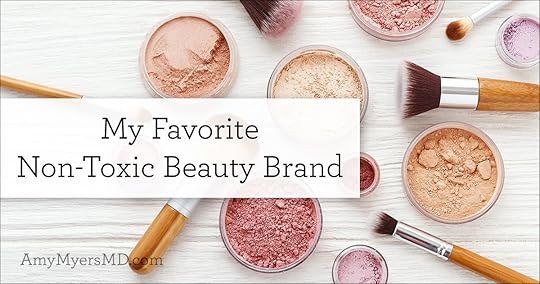Amy Myers's Blog, page 64
January 5, 2018
What’s Behind Your Brain Fog and How to Banish It


“I feel like I’m in a fog, and that my brain isn’t as sharp as it used to be.”
“It’s a struggle to concentrate and stay focused, and I’m not able to think through problems.”
“Managing things like my children’s schedule or planning a family trip suddenly seem overwhelming and impossible.”
“I can’t seem to remember things anymore. I meet someone and I instantly forget their name, I can’t remember where I put my car keys, or I make dinner plans with a friend and then I can’t remember what time we agreed upon.”
I hear these complaints from my patients all the time and I instantly feel for them. It can be incredibly frustrating and even frightening to feel as if you’re losing your edge, and to struggle to do things that used to be simple. My older patients even wonder if they’re becoming senile or are in the early stages of dementia. Brain fog is one of the most common complaints I hear in my clinic.
Fortunately, there is often a very simple and treatable underlying cause of brain fog. And it is lurking somewhere you might not think to look – your gut!
In the vast majority of patients I see who are dealing with brain fog, their symptoms are all caused by a gut infection called yeast overgrowth, commonly referred to as Candida overgrowth. And once their Candida overgrowth is eliminated their brain fog clears, their memory improves, and they feel as sharp as ever.
So let’s talk about what Candida is, why it leaves you in a fog, and how you can eliminate it and get back to feeling like yourself again!
What is Candida Overgrowth?
Candida is a type of yeast, which is a form of fungus. There are actually many different types of yeast that can take up residence in your body, however, Candida albicans (Candida for short) is the most common and studied form of yeast. Most people refer to all types of yeast overgrowth simply as Candida overgrowth, which is what I’ll be doing in this article.
A very small amount of Candida naturally lives in your mouth and intestines to help with digestion and nutrient absorption. Typically the good bacteria in your gut, as well as your immune system, keep it in check.
However, the Candida population can get out of hand if a round of antibiotics kill off too many of those good bacteria, you have a diet high in refined carbohydrates and sugar (which feed the yeast), high alcohol intake, are taking oral contraceptives, are pregnant or have estrogen dominance or any number of other factors including a high-stress lifestyle.
The Candida is then able to multiply unchecked, wreaking havoc on your digestion, breaking down the lining of your intestine and potentially leading to leaky gut, and releasing toxic byproducts into your bloodstream.
This can cause a whole host of symptoms, including gas, bloating, skin issues such as eczema and dandruff, nail fungus, mood swings, anxiety, and depression, itching in your ears, genitals, and anus, and more.
However, the most common symptom I see in my Candida patients is brain fog. So let’s dig into how an overgrowth in your gut could lead to such a frustrating symptom in your brain.
How Does Candida Lead to Brain Fog?
The Candida that has now colonized your gut lives off of sugar, fermenting it to produce energy. This is why another common sign of Candida overgrowth is intense sugar cravings.
This fermentation process produces a number of chemical byproducts, many of which are toxic to you. Two of these chemicals in particular, alcohol and acetaldehyde, are directly toxic to your nervous system and to your brain.
When Candida is kept in check by your good bacteria and immune system, your liver is able to properly process these chemicals and clear them from your body. However, if Candida grows out of control, your liver isn’t able to process and clear all of the toxins from your liver and they build up in your bloodstream and can travel to your brain.
Here are a few of the ways acetaldehyde impairs cognitive function and causes brain fog:
Reduces the amount of oxygen carried by red blood cells to your brain1
Causes a deficiency in vitamin B1, which plays a critical role in brain function2
Damages nerve cells in a similar way to chronic alcoholism or Alzheimer’s3
Free Live Training: How to Beat Candida for Good in 3 Easy Steps

Do you suspect Candida overgrowth is behind your brain fog? Or are you experiencing eczema, dandruff, itching, fatigue, gut issues, or any of the other myriad of symptoms that Candida can cause?
If so, you don’t want to miss my upcoming free live training! During this exclusive, one-hour event, you will discover:
How Candida affects everything from your brain to your skin
The 4 ways Candida gets out of control and becomes Candida overgrowth
The danger of not clearing Candida, and how it can lead to chronic health conditions, including autoimmunity
And most importantly, how YOU can eliminate your symptoms and live a life filled with energy and vitality
Spots are limited and they are filling up fast, so don’t wait, sign up for this free training so that you, too, can beat Candida for good!
The post What’s Behind Your Brain Fog and How to Banish It appeared first on Amy Myers MD.
Slow-Cooker Sweet Potato and Butternut Squash Soup


Slow-Cooker Sweet Potato and Butternut Squash Soup
You may have seen other versions of this delicious Slow-Cooker Sweet Potato and Butternut Squash Soup in The Autoimmune Solution or new patient resources, but they are a little more time intensive. This one is incredibly easy, especially if you have an immersion blender.
Slow-Cooker Sweet Potato and Butternut Squash Soup
CourseAppetizer, Main Dish
ProtocolAutoimmune Solution (AIP), Candida Control & SIBO, Elimination Diet, Paleo, Thyroid Connection
Servings6
Ingredients
2
sweet potatoespeeled and chopped
1
butternut squashpeeled, seeded, and chopped
1
large sweet onion
2cloves
garlicminced
3-4cups
bone broth(less bone broth will yield a thicker soup)
1tsp
cinnamon
1/4tsp
nutmeg
1/2tsp
sea salt
1can
full fat coconut milk
Instructions
Add sweet potatoes, butternut squash, onion, garlic, and broth to slow-cooker. Let cook on high for about 4-6 hours.
When vegetables are soft add cinnamon, nutmeg, sea salt, and coconut milk.
Using an immersion blender, blend until smooth. If you don’t have an immersion blender, transfer ingredients into a regular blender in batches and blend until smooth.
The post Slow-Cooker Sweet Potato and Butternut Squash Soup appeared first on Amy Myers MD.
January 1, 2018
10 Signs the Holidays Wrecked Your Gut


If you found yourself enjoying too many sweets over the holidays and now you’re noticing symptoms such as digestive issues, brain fog, fatigue, dandruff, sugar cravings, skin issues, mood swings, and more – Candida may be the culprit!
Yeast overgrowth, often referred to as Candida, is one of the most common conditions I see in my clinic, particularly among my autoimmune and thyroid patients, and especially after the holidays when many people go a little crazy on the sweets and the wine, two big contributors to Candida overgrowth.
I have also seen the incredible transformation that they experience by beating their yeast. I’ve witnessed energy and vitality return, mental clarity restored, and chronic symptoms fade away.
You might be wondering, “What on earth is Candida?” Candida is a fungus, which is a form of yeast, a very small amount of which lives in your mouth and intestines. Its job is to aid with digestion and nutrient absorption, but when it is overproduced it breaks down the wall of the intestine and penetrates the bloodstream, releasing toxic byproducts into your body and causing leaky gut. This can lead to many different health problems ranging from digestive issues to depression.
How do you get Candida overgrowth?
The healthy or ‘good’ bacteria in your gut typically keeps your Candida levels in check. However, the Candida population can get out of hand if a round of antibiotics kill too many of those friendly bacteria, you have a diet high in refined carbohydrates and sugar (which feed the yeast), high alcohol intake, are taking oral contraceptives, or any number of other factors including a high-stress lifestyle. Even a diet high in beneficial fermented foods like Kombucha, sauerkraut, and pickles, can feed Candida causing an overgrowth. There is also growing evidence that links Candida overgrowth to heavy metals. Some of the evidence suggests this is because heavy metals disrupt your gut, and some suggests that because heavy metals bind to Candida, your body overproduces it as a way to help you clear those heavy metals.
10 Common Candida Symptoms
Skin and nail fungal infections such as athlete’s foot, ringworm, and toenail fungus
Feeling tired and worn down or suffering from chronic fatigue or fibromyalgia
Digestive issues such as bloating, constipation, or diarrhea
Autoimmune disease such as Hashimoto’s thyroiditis, Rheumatoid arthritis, Ulcerative colitis, Lupus, Psoriasis, Scleroderma, or Multiple sclerosis
Difficulty concentrating, poor memory, lack of focus, ADD, ADHD, and/or brain fog
Skin issues such as eczema, psoriasis, dandruff, hives, and rashes
Irritability, mood swings, anxiety, or depression
Vaginal infections , urinary tract infections, rectal itching, or vaginal itching
Severe seasonal allergies or itchy ears
Strong sugar and refined carbohydrate cravings
Do you think you have Candida overgrowth? Take this simple quiz to find out!
How do you test for Candida overgrowth?
IgG, IgA and IgM Candida Antibodies
Blood tests check for IgG, IgA, and IgM Candida antibodies in your blood, and can be performed at most any lab. High levels of these antibodies indicate that an overgrowth of Candida is present somewhere in the body and that your immune system is reacting to it.
Remember, Candida has the ability to suppress the immune system so it is important to ask your doctor to test your total IgG, IgA and IgM levels along with the Candida antibodies. Low levels of total IgG, IgA or IgM could cause a false negative response to the Candida antibodies, meaning you have Candida but since your immune system is lowered, you are unable to produce a response and your blood test comes back negative. Since I see so many patients with suppressed immune systems, I find in my clinic that blood tests can often be negative even when the stool or urine tests are positive.
Complete Blood Count (CBC)
Often, I will see clues on a CBC that let me know that yeast is present. A low white blood cell count (WBC) has been associated with yeast overgrowth as well as a pattern of high neutrophil and low lymphocyte count. While these are non-specific to yeast, after working with thousands of patients, I can tell you I see this pattern very frequently in those with Candida overgrowth.
Stool Testing
I personally find this to be the most accurate test available. This will check for Candida in your colon or lower intestines. However, you need to make sure that your doctor orders a comprehensive stool test rather than the standard stool test. With the stool test, your stool is directly analyzed for levels of yeast. The lab can usually determine the species of yeast as well as which treatment will be effective.
Urine Organix Dysbiosis Test
This test detects D-Arabinitol a waste product of Candida yeast overgrowth. An elevated test means an overgrowth of Candida. This test will determine if there is Candida in your upper gut or small intestines.
How do you treat Candida overgrowth?
Effectively treating Candida involves stopping the yeast overgrowth, restoring the friendly bacteria that usually keep them in check, and healing your gut so that Candida can no longer enter your bloodstream. I accomplish this with a three-wave attack in my simple and proven 30-day protocol for eliminating Candida.
The post 10 Signs the Holidays Wrecked Your Gut appeared first on Amy Myers MD.
December 28, 2017
Vegetable Meatza Pie with Pesto Sauce


Looking to satisfy that pizza craving while sticking to The Myers Way® protocol? Give this “meatza” pie a try for a delicious and creative twist on a classic favorite!
Eating high-quality red meat, in moderation, can be a key component of a healthy diet. Grass-fed bison and beef are a good source of iron, zinc, niacin, selenium, and vitamin B6. Selenium works as an antioxidant, fighting against free-radical damage. Zinc boosts the immune system, and is also a key nutrient in healing the gut. Iron is a critical mineral needed by the body to carry oxygen from the lungs to all tissues. And, all three are essential nutrients for thyroid health!
Vegetable Meatza Pie with Pesto Sauce
CourseMain Dish
ProtocolAutoimmune Solution (AIP), Candida Control & SIBO, Elimination Diet, Paleo, Thyroid Connection
Servings6-8
Prep Time40 minutes
Ingredients
Meatza "Crust"
1lb
ground bison
1lb
ground beef
2tsp
garlic powder
2tsp
oregano
2 tsp
basil
1tsp
thyme
1tsp
parsley
1tsp
sea salt
Meatza Toppings
6cloves
garlicminced
1/2
red oniondiced
1/2container
mushroomssliced
1/2
zucchinisliced
Dino Kale Pestoto taste
More veggies of your choiceoptional: shredded carrots, broccoli or cauliflower florets, mushrooms (if not following the Candida Protocol)
Instructions
Meatza "Crust"
Preheat oven to 350 degrees F.
Place meat in large mixing bowl with garlic powder, oregano, basil, thyme, parsley, sea salt. Mix until thoroughly combined.
Spread mixture on a large baking sheet - make one large ‘pizza’ crust sized shape or two medium shapes.
Bake for 15 minutes.
Meatza Toppings
Spread dino kale pesto over meatza pie “crust”.
Top with meatza toppings.
Cook until vegetables are crisp and meat is fully cooked - about 15-20 minutes.
The post Vegetable Meatza Pie with Pesto Sauce appeared first on Amy Myers MD.
December 26, 2017
Is Gluten to Blame for Your Hashimoto’s?


By now you’re likely at least somewhat familiar with the gluten-free movement. You may have heard that gluten sensitivity can cause health problems and a myriad of symptoms. However, did you know it is particularly damaging for anyone with Hashimoto’s?
In this article I’ll explain why gluten is so harmful for Hashimoto’s and why I recommend that ALL of my thyroid patients eliminate it for good!
The Autoimmune Connection
To understand why gluten is so harmful for your thyroid, you first need to know that Hashimoto’s is an autoimmune disease. This means that your immune system is mistakenly attacking your own thyroid, causing it to underproduce thyroid hormones.
Shockingly, many people with thyroid dysfunction don’t even know if their condition is autoimmune-related or not. This is because conventional doctors don’t routinely check for thyroid antibodies when testing thyroid blood levels. I could go on for days about why this is such a disservice to patients, and I cover this much more in-depth in my book, The Thyroid Connection.
The important thing to know is that if you have Hashimoto’s or any other autoimmune condition is that it’s a problem of the immune system, not the individual gland or organ (in this case your thyroid), and by supporting your immune system you can REVERSE your condition. I walk you through how to do that in my book.
So if Hashimoto’s is caused by autoimmunity, what causes the autoimmunity in the first place? The answer is complex, but without a doubt, one of the biggest contributing factors is gluten. Gluten wreaks havoc on your gut, increases your inflammation, and can directly cause your immune system to attack your thyroid. Let’s take a look at how and why that is.
Gluten, Leaky Gut, and Hashimoto’s
Thanks to the pioneering work of Dr. Alessio Fasano, we know that leaky gut is one of the primary triggers for all autoimmune disease, including Hashimoto’s. As you might guess by its name, leaky gut occurs when your gut (specifically your small intestine) becomes permeable, allowing particles to leak from your digestive tract and travel freely through your bloodstream.
Gluten is one of the main causes of leaky gut in people that I see with thyroid issues and autoimmune diseases, and not just among Celiac patients, but in anyone with gluten sensitivity. When anyone, whether they have gluten sensitivity or not, eats a gluten-containing food, the gluten proteins make their way through the stomach and arrive at the small intestine, where the body responds by producing zonulin, a chemical that signals the tight junctions of the intestinal walls to open up, creating temporary permeability.
This permeability will heal as the gut cells renew every 48 hours. However, if you have gluten sensitivity and you eat gluten, then this permeability will not heal in that 48 hours and your gut remains leaky. Leaky gut can also be caused or exacerbated by gut infections such as Candida overgrowth or SIBO, medications such as antibiotics, steroids or birth control pills, as well as a high stress lifestyle. New research shows that spraying Glyphosate (Roundup) on the wheat is also a major contributor of leaky gut and gluten sensitivity.
Now that your small intestines are open and permeable this allows toxins, microbes, and partially digested food to leak into your bloodstream, your immune system goes on high alert to neutralize all of these threats. But, because your gut is still leaky, the threats just keep on coming, putting your body in a state of chronic inflammation and putting you on the path to develop an autoimmune disease (including Hashimoto’s) as your immune system becomes so stressed and confused that it begins attacking your own tissue by mistake. Unfortunately, the gluten that caused your gut to become leaky makes it even more likely that you will develop thyroid dysfunction (autoimmune and non autoimmune), thanks to a phenomenon called molecular mimicry.
Molecular Mimicry, A Case of Mistaken Identity
Every time your body is exposed to a bacteria, virus, or other pathogen, your immune system memorizes its structure, specifically its protein sequence, so that it can recognize it in the future and mount a defense.
However, the immune system’s recognition system isn’t foolproof; as long as a molecule’s structure and protein sequences are similar enough, the immune system can be fooled into attacking look-a-like molecules that are actually your body’s tissue, causing autoimmune disease. Unfortunately for the thyroid, it has a common doppelganger that puts it at risk for rogue autoimmune attacks. You guessed it – gluten. What’s more, 50% of people with gluten sensitivity experience molecular mimicry with casein (a protein found in dairy). This is known as cross-reactivity, where you react not only to your original trigger, but also to another trigger that resembles the first one.

Thanks to the leaky gut that was originally caused by gluten, every time you eat gluten and dairy, their proteins are able to escape into your bloodstream, where they trigger an attack from your immune system. And, because of the molecular mimicry phenomenon, your thyroid tissues end up in the crosshairs as well.
How to Repair the Damage Caused by Gluten
The bottom line is, if you have Hashimoto’s, I recommend that you ditch gluten and dairy for good. Once you’ve eliminated them from your diet, your gut can begin to repair itself, your inflammation will decrease, and your body will slow and eventually stop its rogue attacks on your thyroid.
That’s why removing gluten and dairy are part of the first step of functional medicine’s 4R approach to repairing leaky gut.
I walk you through this entire approach in depth in my book, The Thyroid Connection, along with providing a step-by-step 28-day program to make putting it into practice simple and stress free. Here are the basics of the 4R approach that I cover:
Remove. Remove the bad, getting rid of factors that negatively affect the gut, including inflammatory foods such as gluten, dairy, corn, soy, eggs, and sugar, infections from parasites, yeast, or bacteria, and irritants such as alcohol, caffeine, and drugs.
Replace. Replace the good, adding back the digestive enzymes required for proper digestion.
Reinoculate. Restore a healthy balance of good bacteria by reintroducing beneficial bacteria through a high-quality, multi-strain, high-potency probiotic supplement.
Repair. Provide the nutrients necessary to help restore your gut lining. One of my favorite supplements is collagen which is rich in amino acids that quite literally, “seal the leaks” or perforations in your gut by repairing damaged cells and building new tissue. Another one of my favorites supplements is L-glutamine, an amino acid that helps to rejuvenate the gut wall lining.
You can find all four of the gut-repairing supplements listed above (with a 10% discount!) in my Leaky Gut Repair Kit.
Beat Hashimoto’s Symptoms for Good!

Find out why conventional medicine gets Hashimoto’s wrong and what’s really causing your symptoms.
You’re about to discover:
What diet is best for Hashimoto’s
Why you can still feel like crap, even if your doctor says your labs are fine
What thyroid medication is best for Hashimoto’s
And how to finally drop those stubborn pounds!
Click here to get the secrets!
The post Is Gluten to Blame for Your Hashimoto’s? appeared first on Amy Myers MD.
December 22, 2017
Dairy-Free “Egg” Nog


Egg Nog is definitely a holiday favorite, but is typically packed with dairy and of course, eggs. Try my Dairy-Free “Egg” Nog for a creamy take on this holiday classic that won’t put your dietary protocol on hold!
Find this, and over 40 other The Myers Way®- friendly recipes for the holidays in The Myers Way® Holiday Recipe eBook!
Dairy-Free "Egg" Nog
ProtocolAutoimmune Solution (AIP), Paleo, Thyroid Connection
Servings4 servings
Ingredients
4cups
Tigernut horchata(orignial or chai flavor)
1cup
coconut cream
4
datespitted
1tsp
pure vanilla extract
1tbsp
grass-fed gelatin powder
1/4tsp
nutmeg
1/8tsp
cloves
1/8tsp
salt
Instructions
Place all ingredients into a high speed blender and blend on high until smooth.
Place blended ingredients into a medium saucepan and whisk frequently until gelatin dissolves and mixture is warmed through. Serve immediately.
The post Dairy-Free “Egg” Nog appeared first on Amy Myers MD.
December 18, 2017
7 Steps to Reset Your Sleep Cycle


You already know that sleep is important, but did you know that your sleep cycle, or circadian rhythm, actually determines your hormones, energy levels, and how well you recover from illness?
The word circadian comes from the latin circa, meaning “about” or “around,” and diem, meaning “day.” Your sleep cycle is “about a day,” or about twenty-four hours. Before clocks and electric lighting, our ancestors woke with the sun, and went to sleep when it got dark, which is exactly the way your body is designed to function. Staying up too late, spending too much time indoors, and getting false energy from caffeine and sugar can upset your body’s rhythm and throw off your immune system and hormones.
Let’s look at some of the ways you can reset your circadian rhythm and have deep, restorative sleep at night, and lasting energy during the day:
1. Aim for 8 to 9 hours of sleep each night.
This is the amount that most people are going to need, but you can find your ideal number by seeing when you wake naturally without an alarm. You might want to try this method over a weekend.
Sleep is a crucial part of healing. It’s when we are asleep that our bodies can repair damaged tissue and quell inflammation.
2. Skip the caffeine and sugar.
Caffeine and sugar make it hard to tell when you need sleep because they give you a false sense of energy. They only perk up your mind, tricking you into thinking you aren’t tired, when your body is telling you just the opposite!
Practice reading your body’s natural cues. It may seem obvious, but when you’re tired, go to sleep. Don’t stay up reading, watching TV, or browsing the internet when your body is giving you obvious signs of sleepiness. It’s doing so because it needs time to repair itself.
3. Spend time outside.
Just as you need to be in the dark at night, you need to be in the light during the day! Specifically, the sunlight. Get outside and expose yourself to the sunlight at least 3 times a day, which will not only help to reset your sleep cycle, but it will increase your Vitamin D production.
Being connected to the ground can also help to correct your internal clock and relieve stress. Because 90% of our time is spent indoors, so many of us are physically cut off from the earth. So take a nap on the beach, walk barefoot through the grass, or get your hands dirty in a garden. Do something every day that will put your body in direct contact with the earth.
4. Limit use of electric lighting after sunset.
Too much electric lighting can trick your body into thinking it’s day time when it’s actually night. Because your hormone production responds to light, lighting your house after sunset can prevent you from getting a deep and healing sleep.
Turn off overhead lights once the sun goes down, and keep your lamps as dim as possible in the evening. Sleep in a dark room, or use blackout curtains or a sleeping mask. This will help reprogram your inner clock to recognize night time as a time for sleep, and daytime as a time to be awake and energetic. If you aren’t able to dim your lights, you can replace them with amber light bulbs, which emit a different frequency of light that does not interfere with your circadian rhythm. I myself put amber light bulbs in a few cheap lamps, and I use only this second, dimmer set of lamps after the sun goes down. If I need to get up after I’ve gone to bed, I use my cell phone as a dim flashlight and avoid turning on any lights.
5. Turn off all electronic devices two hours before sleep.
Many of us like to watch TV or use our computers before bed, but these devices emit light. Your sleep cycle adjusts according to light, and receiving too much at night can make it hard for you to fall asleep by disrupting your melatonin production. Reading with a dim bedside lamp is a much better alternative.
Sometimes one’s job makes it impossible to avoid using electronic devices late at night. If you’re usually working late on your computer or reading on your iPad, you can download the f.lux app that adjusts to the time of day and creates an amber hue on the screen after dark.
My favorite sleep tool, and the one I won’t travel without, is my pair of amber glasses! The amber-colored lenses in the glasses literally block out the blue light that reduces melatonin production, so that your body naturally gets sleepy as you near bedtime. Since I started wearing them, I’ve seen a huge difference in my ability to fall and stay asleep each night.
6. Go with the seasons.
You’re probably thinking that it’s going to be difficult to power down your electronics, dim your lights, and prepare for bed in the winter time, when it can start to get dark in the afternoon. Will you be sleeping too much?
The truth is, just as your body is designed to move with the day, it’s also designed to move with the seasons. You will sleep more during the winter, and that’s what you need. Winter is a time to conserve your energy and repair your body, especially if you live in a colder climate. Appetites change seasonally, and so do sleep requirements.
7. Consider Melatonin to support healthy sleep patterns.
As I mentioned above, our modern-day habit of keeping the lights on until the very last minute before we head to bed is affecting our sleep cycle and melatonin production.
Melatonin is incredibly important to our sleep cycle, it is naturally produced in the pineal gland in response to changes in light exposure and helps promote healthy sleep patterns as well as free radical scavenging and immune activities. My Melatonin Sustained Release uses a unique delivery system that releases melatonin quickly, for help falling asleep, and then again steadily throughout the night, for help staying asleep.
You can make these changes all at once, or one at a time. Taking care of your circadian rhythm will help you sleep well and wake refreshed.
The post 7 Steps to Reset Your Sleep Cycle appeared first on Amy Myers MD.
December 14, 2017
Peppermint Bark


This Peppermint Bark is The Myers Way®-approved, looks and tastes just like the holiday season, and features a holiday flavor staple: peppermint!
Peppermint Bark has become a popular dessert option for the holidays, but is loaded with sugar and dairy. There are tons of variations of this Christmas treat favorite, but mine avoids inflammatory ingredients that could disrupt your protocol. Don’t worry, you won’t even notice a difference in taste!
And this recipe is perfect for when you don’t have much time on your hands, yet want to enjoy a sweet treat. It is super simple to prep and make! There is no need for an oven, and the recipe only calls for five ingredients!
Once the bark has hardened, you can gift this sweet treat to a friend following The Myers Way®, break it up to top off other desserts (such as gluten-free cookies!), or simply eat it straight! Enjoy!
Find this, and over 40 other The Myers Way®- friendly recipes for the holidays in The Myers Way® Holiday Recipe eBook!
Peppermint Bark
CourseDessert
ProtocolAutoimmune Solution (AIP), Paleo, Thyroid Connection
Servings8 servings
Ingredients
1/4cup
coconut oil
1/4tsp
stevia
3tsp
peppermint extract
1/2cup
coconut butter
1tbsp
water
freeze-dried fruitoptional
coconut chipsoptional
carob powderoptional
Instructions
In a small saucepan on low heat, melt together coconut oil, stevia, and peppermint extract. Let cool.
Place melted mixture and remaining ingredients in blender until mixed together.
Pour mixture onto baking sheet lined with parchment paper. Sprinkle optional toppings on bark and place in freezer for 2 hours or until set.
Break into desired shapes. Store in either refrigerator or the freezer.
The post Peppermint Bark appeared first on Amy Myers MD.
December 12, 2017
How to Recover from Holiday Gluten Exposure


Recently I’ve been sharing tips for surviving and thriving during the holidays, including how to stay healthy and stress-free during the holidays, and some great gift ideas for promoting health, because I know the holidays can often make sticking to a protocol, relieving stress, and avoiding inflammatory foods that much tougher. During the holiday season, if you’re out at holiday parties, going to potlucks, or having holiday meals with your family, it’s more likely that you may accidentally ingest gluten — otherwise known as getting “glutened”— while enjoying the celebration!
The outward manifestation of getting glutened may be different for everyone, and can cause a variety of symptoms such as brain fog, diarrhea, constipation, headache, rash, weakness, joint pain, swelling, vomiting, and fatigue. However, inside your gut, the effects are essentially the same; gluten is wreaking havoc. Gluten causes inflammation and damage to the intestines, which can trigger or cause a flare in autoimmune disease. It can also cause your immune system to attack your thyroid, worsening thyroid dysfunction symptoms. Gluten also causes inflammation and damage to the intestines, leading to leaky gut. Ridding yourself of this inflammatory protein, reducing inflammation and healing your gut from the damage are essential to recovering as quickly as possible.
Now I want to walk through some proven tips for you to keep in your back pocket so that you’re prepared if getting ‘glutened’ happens to you!
3 Steps To Recover After Getting Glutened
1. The more quickly you can get the gluten out of your system, the better you’ll feel.
These three things will help you do that promptly and effectively:
Digestive Enzymes. Digestive enzymes help speed up the breakdown and absorption of macronutrients. Be sure to take an enzyme that includes dipeptidyl peptidase (DPP-IV), which helps break down gluten specifically. In fact, I recommend that those with celiac and gluten intolerance take enzymes with DPP-IV when dining out.
Binding agents. Activated charcoal and bentonite clay bind toxins and help reduce gas and bloating. It’s best to increase water intake when taking either of these to avoid constipation, which will only delay healing.
Hydration. Fluids will help flush your system and keep you hydrated if you’re vomiting or have diarrhea. In addition to regular water, you can try coconut water, which contains electrolytes that may have been lost through vomiting or diarrhea.
2. Decrease inflammation in order to heal your gut as soon as possible.
Inflammation occurs naturally in our body when there has been an insult or injury to it. Decreasing this inflammation is essential to healing your gut. These three things will help you reduce inflammation quickly:
Omega-3 fatty acids. Fish oils, flax and chia seeds are full of anti-inflammatory omega-3 fatty acids. I recommend 1-2 grams of omega-3 oils daily. You can go up to 4 grams a day for a week after accidental gluten ingestion.
Ginger has high levels of gingerol, which gives it a natural spicy flavor and acts as an anti-inflammatory in the body. It also has potent anti-nausea properties and can ease stomach cramping. I like to drink warm ginger tea as a comforting, anti-inflammatory beverage.
Turmeric is a member of the ginger family that contains the active ingredient curcumin, which is known for its antioxidant and anti-inflammatory properties. My anti-inflammatory smoothie with turmeric is a great drink to help you quickly recover from getting glutened.
3. Repair your gut to keep your immune system functioning optimally.
Nearly 80% of our immune system is in our gut. Having a healthy gut is crucial for optimal health. The four things below will help you repair your gut.
Probiotics. Routinely, I recommend taking a highly concentrated probiotic (25-100 billion units) a day to maintain healthy levels of good bacteria. I advise my patients to “double-up” on their probiotic dose for a week after a gluten exposure.
L-Glutamine. Glutamine is an amino acid that is great for repairing damage to the gut, helping the gut lining to regrow and repair, undoing the damage caused by gluten. I recommend 3-5 grams a day for a week after exposure.
Collagen is very high in the anti-inflammatory amino acids glycine and proline and peptides that help maintain and promote optimal gut lining health that may get disrupted by being glutened. The cells lining your intestinal tract use collagen to promote tissue repair and a healthy intestinal barrier. Supporting the gut lining is absolutely paramount for those concerned with autoimmunity, healthy thyroid function, and a balanced and normal inflammation response.
Once you realize that you have been glutened, implement this three-step approach as soon as possible. If your symptoms persist or if you’ve had multiple exposures from holiday overindulgences or from getting off track and you’ve been following one of the programs from my books The Thyroid Connection and The Autoimmune Solution, I recommend getting back on the program until your symptoms go away. Or if you haven’t yet started my programs, right after the holidays is the perfect time to start!
I hope you have a happy, healthy, and gluten-free holiday with your loved ones, and a very happy start to 2017!
Reverse Chronic Illnesses So You Can Take Back Your Health!
Are you ready to beat your symptoms, regain your energy, and feel like yourself again? Whether you have Hashimoto’s, Graves’, or any of the hundreds of other autoimmune diseases, I want you to know you CAN reverse your condition!
Tens of thousands of people around the world have already taken back their health using my New York Times Bestsellers, The Autoimmune Solution and The Thyroid Connection. Are you ready to join them?
In each book you’ll learn how to address the true underlying causes of your symptoms using simple yet proven dietary and lifestyle changes. Best of all, you’ll get step-by-step, four-week plans to put all of the principles into practice and truly make optimal health a way of life!
The post How to Recover from Holiday Gluten Exposure appeared first on Amy Myers MD.
December 11, 2017
My Favorite Non-Toxic Beauty Brand


Did you know that the average person uses 10-15 personal care products with 126 different ingredients every day?1 Your skin is your biggest organ, and what you put on it, you also absorb! This is why it is SO important to know what you are putting ON your body, not just in it.
Now, the FDA does NOT test cosmetic ingredients for safety. Instead the Cosmetic Ingredient Review (CIR), an industry-appointed and funded panel, reviews the safety of cosmetic ingredients.2
According to the Environmental Working Group (EWG), there are approximately 10,500 ingredients used in cosmetics in the US, and in its 30 year history, the CIR has screened only 11 of those ingredients.3 The CIR argues that it’s okay to put these toxic ingredients into products because only tiny amounts are used in each product. Therefore, they are not harmful. However, because of the number of products we are using, this simply isn’t true.
There are ~10,500 ingredients used in cosmetics in the US, and the CIR has screened only 11 of them
Click To Tweet
Let me give you an analogy: each person has a cup. This represents the chemicals that enter your system. Hopefully, when we are born, that cup is empty. As you age and are exposed to more toxins and chemicals, drops are added. Each drop represents toxins and chemicals that have invaded your system.
If the cup overflows, the result is chronic sickness and autoimmunity.
The rise of toxic personal care products has had a terrible impact on not only our health, but our children’s health as well. That’s why taming the toxins is the third step in The Myers Way® and all of my programs.
Beautycounter: Non-Toxic Beauty & Personal Care!
So how do you tame the toxins in your beauty and personal care routine?
The first thing I recommend is to find a company you know you can trust – just like I did with Beautycounter.
They have a 5-step approach to providing safe and researched products, and a “Never List” of 1,500 ingredients found to be unsafe not just in American standards, also Europe and Canada where testing is more stringent that they strictly avoid using. I have been using many of their products, and I’m hooked! That’s saying a lot, because I have VERY high standards for my personal care products!
Every ingredient Beautycounter uses is sourced from GMO-free sources, and is tested for safety. They are continuously researching and updating their list based on academic and non-profit research, as well as government studies. Additionally, 80% of ingredients are organic, natural, or plant derived, while the synthetic 20% are thoroughly researched and tested.
Reverse Chronic Illnesses So You Can Take Back Your Health!
Are you ready to beat your symptoms, regain your energy, and feel like yourself again? Whether you have Hashimoto’s, Graves’, or any of the hundreds of other autoimmune diseases, I want you to know you CAN reverse your condition!
Tens of thousands of people around the world have already taken back their health using my New York Times Bestsellers, The Autoimmune Solution and The Thyroid Connection. Are you ready to join them?
In each book you’ll learn how to address the true underlying causes of your symptoms using simple yet proven dietary and lifestyle changes. Best of all, you’ll get step-by-step, four-week plans to put all of the principles into practice and truly make optimal health a way of life!
The post My Favorite Non-Toxic Beauty Brand appeared first on Amy Myers MD.
Amy Myers's Blog
- Amy Myers's profile
- 74 followers




